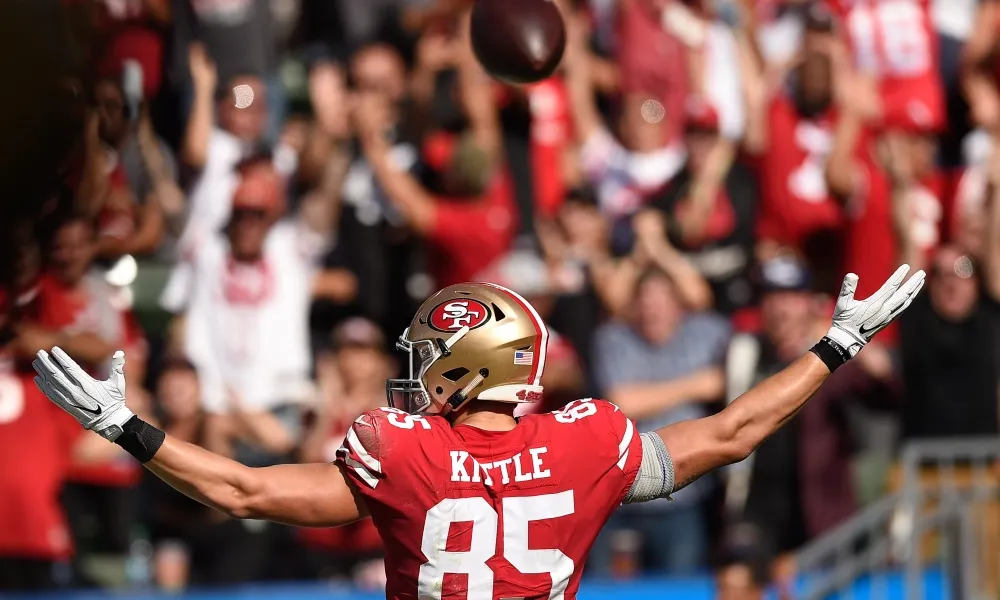
Elite TE is Going Out of Style... but it's Going Out on Top
Fantasy football tends to be a game where whatever worked in the most recent season drives the narrative for the following year's drafts. But at tight end, we're not seeing that dynamic play out.
Drafting an elite tight end (which I'm defining as a tight end drafted in Rounds 1-5) was a dominant strategy in 2022. The winning lineups in major tournaments throughout the industry were heavily weighted toward elite TE teams, including the flagship best ball tournaments on FFPC (playoff format), Drafters (total points), NFFC (total points), and Underdog (regular season total points and playoffs).
DraftKings is a slight exception. T.J. Hockenson was the top tight end on the $1 million winning lineup there. And although Hockenson was going in the single-digit rounds, he didn't qualify as an elite tight end. However, the winning lineup in DraftKings' $555 tournament (for $250,000) was built on a Round 1 tight end selection.
So it was an amazing year for elite TE builds. Yet drafters seem wary of the strategy.
Elite TE Didn't Feel Elite in 2022
I'll get into 2023's ADP landscape in a bit, but first, I want to look at the recent results in more detail. Because although elite TE had a great 2022, it clearly didn't leave a great impression on best ball drafters.
And sure enough, when using the RotoViz Roster Construction Explorer, the strategy looks fairly whatever at first glance. Advance rates were slightly below expected overall and just a hair above expected when drafters stopped at two TEs.
Sure, elite TE teams made noise in the fantasy playoffs... but if you didn't make the playoffs in the first place, that didn't help you.

We saw a very similar dynamic in 2021, with elite TE slightly hurting advance rates.

And then there's the obvious fact that, outside of Travis Kelce, every early-round tight end was a drag on rosters during the 2022 regular season.

Points Above Replacement
Hayden Winks has recently argued against the elite TE strategy, writing:
"I also don't think the narrative that the elite TEs separate from the rest is actually true after looking at the #math. Last year, Travis Kelce had the 2nd best half PPR season of all time at TE, but his fantasy points over replacement using Underdog Fantasy scoring checked in at 13th overall. Of the top-500 weekly scores last year, he only had 3 of them ... because going off at TE means getting 20 half PPR points, while going off at QB, RB, or WR means getting 30 half PPR points."
Hayden notes that the elite TEs' ability to distance themselves from the competition may be overstated. This is because best ball lineups only require one starter at the position. And while beating the TE12 by a wide margin is nice, an elite RB or WR isn't going up against the 12th player at their position; they're going against the 24th or 36th, which can create a much more significant gap in points above replacement.
This effect can be seen in Hayden's value over replacement chart, which measures "how much the top player at each position separated from their positional replacement on average each week."

Per the chart above, the top tight end only averaged 14.6 points above replacement, while the top RB averaged 25.2 over replacement, and the top WR averaged 23.9.
So... tight ends score fewer points above replacement than RBs and WRs, and most are hurting advance rates. It seems pretty clear that elite TE is fool's gold... unless advance rates and points over replacement aren't what we're optimizing for.
Elite TE is a Playoff Hammer
When looking at Round 1 advance rates over the last two years – meaning, advancing to the playoffs – elite TE doesn't look that great. But when looking at advance rates in the single-week elimination tournaments... it looks much better.

Let me get some crucial caveats out of the way. First, we only have two years of finals data in the RotoViz RCE tool, and these numbers would look very different if Mark Andrews and George Kittle had simply shifted the timing of some crucial spike weeks.
There's also the fact that, as noted above, these advance rates are hugely propped up by Travis Kelce's elite year. Therefore, the advance rate risk when selecting a non-Kelce elite TE was much more significant than this chart would lead you to believe.
Sure enough, if you look at teams who selected their TE1 in Rounds 3-5 (removing Kelce from the sample), advance rates drop dramatically.

This matches what it felt like to have a non-Kelce "elite" TE last season. Kyle Pitts and Darren Waller were particularly crushing, but selecting any elite TE meant potentially passing on major hits like Tyreek Hill, A.J. Brown, Josh Allen, Jaylen Waddle, Patrick Mahomes, and Amon-Ra St. Brown.
But even when stripping out Kelce, elite TE performed great in the playoffs—because George Kittle was a league winner.
Entering Week 15, Kittle had topped 50 yards just three times in 11 games. And he'd totaled just four TDs. But Kittle came to life against the Seahawks, posting a 4/93/2 receiving line. The following week, he went nuts, with 6/120/2 receiving against the Commanders. He was pretty quiet in Week 17 but got in the end zone at least, posting 4/23/1.
Kittle's extremely well-timed spike weeks significantly boosted elite TE playoff performance rates. He was on 39% of the 470 teams in the BBM3 championship. Only Justin Jefferson (41%) was on a higher percentage of teams.
Despite a quiet Week 17, Kittle was on my winning BBM3 lineup, as well as the winning FFPC lineup. And interestingly, despite it being a total points (Weeks 1-17) contest, he was also on the winning Drafters lineup. So whether looking at half PPR, full PPR, or TE premium, and whether looking at the playoffs or total points through Week 17... you wanted Kittle on your team last season.
But given Kittle's below-average advance rate, did the lineups that won with him just get lucky that his points came in predominantly late-season spike weeks?
Yes!
Every Kittle drafter got extremely lucky that his point distribution worked out the way it did.
But here's the thing, if you're firing at a massively top-heavy tournament, you'll need a few things to break your way. And while Kittle drafters dramatically benefited from his point distribution, they also benefited from something more predictable: very little competition from the rest of the tight end position.
George Kittle was one of just 15 tight ends to hit 20+ half-PPR points. More importantly, he was one of just three TEs to hit 20+ points more than once. The other two... were Travis Kelce and Mark Andrews.
Fewer Right Answers
Drafting an early-round tight end can feel like a wasted pick. Unfortunately, the build probably won't boost your advance rates, and odds are the tight end position will be a wasteland again this season, as it always seems to be.
But keep in mind that the overall weakness of the tight end position is a feature, not a bug, of the elite TE strategy. You're only drafting one of these guys on a given team. If all but one or two of them is a bust, that's not the most fun thing in the world for your other teams... but it makes the surviving elites genuinely elite.
When a WR or RB hits 20+ points, it's a big deal, but it's also fairly common. For example, from Weeks 1-17 last season, we had 105 20+ point outings from RBs, for an average of 6.2 a week. And we had 100 20+ point weeks from WRs, for an average of 5.9 a week.
But tight end was a wasteland. We had only 22 20+ point outings all season, for an average of just 1.3 a week.
When a tight end hits 20+ fantasy points, he instantly becomes a favorite to be the highest-scoring TE of the week, giving you an uncommon advantage at the lowest-scoring position.
And although there were only 22 TE spike weeks last season, Kelce, Andrews, and Kittle each had three of them. In combination, they accounted for 41% of the 20+ point outings at the position.


